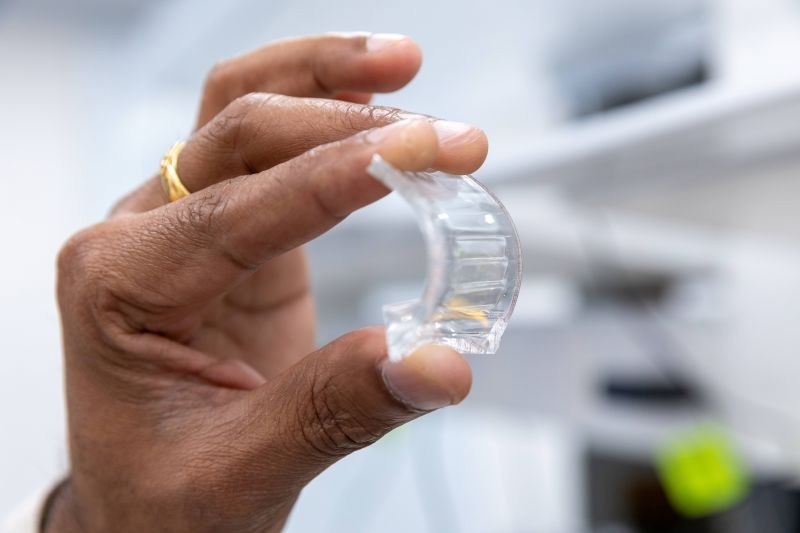Researchers from the University of Melbourne, KDH Design Corporation, and the Melbourne Centre for Nanofabrication (MCN) have developed the first flexible, transparent augmented reality (AR) display screen using 3D printing and inexpensive materials. The creation of the new display screen is expected to improve the use of augmented reality in several fields and applications.

The flexible, transparent polymer-based material will advance how AR is used across a range of industries. Image Credit: Cesar Nicolas
AR technology improves a user’s real-time perception and interaction with their surroundings by superimposing digital material over the real world.
Since most current mainstream AR production employs glass substrates, which must go through photomasking, laminating, cutting, or etching microstructure patterns, it has been difficult to develop flexible AR technology that can adapt to varied angles of light sources.
These laborious procedures are costly, have a low output rate, and are challenging to integrate smoothly with product appearance designs.
Under the direction of the University of Melbourne researchers Associate Professor Ranjith Unnithan, Professor Christina Lim, and Professor Thas Nirmalathas, in collaboration with Taiwanese KDH Design Corporation, the team has successfully created a transparent AR display screen using low-cost, optical-quality polymer and plastic—a first-of-its-kind accomplishment in the field of AR displays.
The team’s method was a revolutionary one for AR displays since it made use of additive manufacturing, commonly known as 3D printing, in the creation process.
The manufacturer of AR helmets for motorcycles and military goggles, KDH Design Corporation, will include this new technology in the visor of head-worn gadgets, including AR glasses, AR sports goggles, AR helmets, and AR automotive displays.
A designer has more freedom to match a product form factor since the display screen is adaptable and flexible enough to bend and fit varied forms, such as curved or uneven surfaces. The display panel is translucent, giving viewers an unimpeded, natural vision while superimposing digital content.
Furthermore, additive manufacturing techniques enable accurate control over design and production, resulting in higher quality products as well as the potential for cost-effective and scalable mass manufacturing, making the technology accessible and cost-effective for a wider range of applications.
According to Associate Professor Unnithan of the Faculty of Engineering and Information Technology, this is a milestone in the realm of AR technology with several possible applications.
In the gaming industry, flexible and transparent AR displays could be integrated into gaming accessories such as goggles or visors, providing a more immersive and realistic gaming experience.
Ranjith Unnithan, Associate Professor, Faculty of Engineering and Information Technology, The University of Melbourne
He added, “In education, AR displays could be incorporated into educational tools and simulations, allowing for interactive and engaging learning experiences. In healthcare, AR displays could be used in medical training, assisting surgeons with real-time information during operations, but there are many other potential applications, from transport to tourism.”
Alumnus of the University of Melbourne and CEO of KDH Design Corporation, Jeremy Lu, stated the innovation came about as a result of four years of collaborative research.
The ultimate AR technology we had in mind, based on our research, had to be very thin, very power efficient, and very light, so we can adapt the AR ‘film’ for near-eye applications, such as AR glasses and goggles. We also wanted to be able to use the AR technology for transparent displays, for example, in car windscreens.
Jeremy Lu, Chief Executive Officer, KDH Design Corporation
According to KDH Corporation CTO Younger Liang, the firm was able to create a prototype that realized KDH’s goal, thanks to its partnership with University and Melbourne researchers.
We can now commercialize this technology for a wide range of new and exciting applications.
Younger Liang, Chief Technology Officer, KDH Design Corporation
The University of Melbourne and KDH Design Corporation will work together with Professor Nicolas Voelcker, Scientific Director of the Melbourne Centre for Nanofabrication, to “support their efforts to develop new flexible materials for augmented reality displays.”
Voelcker stated, “The MCN is a world-class nanofabrication center, combining cutting-edge technologies with the knowledge and skills of expert process engineers.”
KDH Design Corporation, a research partner of the University of Melbourne since 2019, is the owner of the patents and intellectual property for this study. Both parties are excited to work together again on future projects. The new technique is now prepared for mass production, and patent applications have been made in the United States of America.